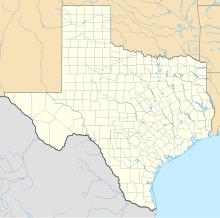East Texas Regional Airport
East Texas Regional Airport | |||||||||||||||
|---|---|---|---|---|---|---|---|---|---|---|---|---|---|---|---|
| Summary | |||||||||||||||
| Airport type | Public | ||||||||||||||
| Owner | Gregg County | ||||||||||||||
| Serves | Longview, Texas | ||||||||||||||
| Elevation AMSL | 365 ft / 111 m | ||||||||||||||
| Coordinates | 32°23′02″N 094°42′41″W / 32.38389°N 94.71139°W | ||||||||||||||
| Website | Official website | ||||||||||||||
| Map | |||||||||||||||
 | |||||||||||||||
| Runways | |||||||||||||||
| |||||||||||||||
| Statistics (2011) | |||||||||||||||
| |||||||||||||||
East Texas Regional Airport (IATA: GGG, ICAO: KGGG, FAA LID: GGG) is an airport located in Gregg County, Texas.[1] The airport is just South of the city of Lakeport, and is 9 mi (7.8 nmi; 14 km) south of Longview. Its IATA identifier GGG comes from its prior name, Gregg County Airport. The airport is used for general aviation and military training; it has scheduled flights to Dallas/Fort Worth on American Airlines/American Eagle.
Federal Aviation Administration records say the airport had 24,835 passenger boardings (enplanements) in calendar year 2008,[2] 24,944 in 2009 and 21,830 in 2010.[3] The National Plan of Integrated Airport Systems for 2011–2015 categorized it as a primary commercial service airport (more than 10,000 enplanements per year).[4]
East Texas Regional is home to LeTourneau University's School of Aeronautical Science. LeTourneau constitutes a very large portion of the airport's traffic and has a fleet of airplanes ranging from Cessna 172s to Citabrias and Diamond DA-42 Twinstars. Most LeTourneau aircraft have tail numbers ending in "LU". All use the call sign "Jacket" (three letter- JKA).[5]
Each summer the airport hosts the Great Texas Balloon Race, a volunteer-run weekend event held annually since 1980.[6]
History
Construction of the Gregg County Airport and terminal was completed and the airport opened on 15 July 1947. Once open, Mid-Continent and Delta airlines serviced the airport with commercial flights. Many improvements happened over the years, including runway lights, approach lights, and an instrument landing system. Big changes came in 1970, when the 10,000 ft (3,000 m) paved runway 13/31 was completed, and in 1976 when a new air traffic control tower was built.[7] In 2002, the airport was renamed the East Texas Regional Airport. In 2007 the airport was awarded a $6.5 million Airport Improvement Program grant to accomplish major updates to the facility.[8] Included among the projects were the resurfacing of Runway 13/31, as well as the relocation of the ILS glideslope and MALSR due to the creation of an 800' displaced threshold on Runway 13 to comply with FAA runway safety area standards. Former taxiway H (at the intersection of 18/36 and 13/31) was demolished after being identified as a potential hot spot for runway incursions.[9] The improvements were completed in 2009.
On 8 October 1992, the airport was the first of two stops for Ferry Flight 58 of Space Shuttle Atlantis between the Kennedy Space Center and Palmdale, California, where Atlantis was sent for orbiter maintenance.[10][11]
Runway 13/31 was a stand-by recovery point for the Space Shuttle Program.[citation needed]
Facilities
East Texas Regional Airport covers 1,300 acres (530 ha; 5.3 km2) at an elevation of 365 ft (111 m). It has two asphalt runways:
In the year ending June 30, 2011 the airport had 74,950 aircraft operations, average 205 per day: 91% general aviation, 6% military, 2% air taxi, and 1% airline. 99 aircraft were then based at this airport: 58% single-engine, 23% multi-engine, 18% jet, and 1% helicopter.[1]
Two fixed-base operators (FBOs) are on the field: Stebbins Aviation and KRS Jet Center.[12]
Airline and destination
| Airlines | Destinations |
|---|---|
| American Eagle | Dallas/Fort Worth |
| Destination map |
|---|
Destination from East Texas Regional Airport |
References
- ^ a b c d e FAA Airport Form 5010 for GGG PDF. Federal Aviation Administration. Effective May 31, 2012.
- ^ "Enplanements for CY 2008" (PDF). Federal Aviation Administration. December 18, 2009.
- ^ "Enplanements for CY 2010" (PDF). Federal Aviation Administration. October 4, 2011.
- ^ "2011–2015 NPIAS Report, Appendix A" (PDF). Federal Aviation Administration. October 4, 2010. Archived from the original (PDF) on September 27, 2012.
- ^ FAA Aircraft Registry, 2010
- ^ Great Texas Balloon Race Story, 2010, archived from the original on 2009-01-24, retrieved 2010-11-11
- ^ "East Texas Regional Airport: Our History". Retrieved October 9, 2019.
- ^ FAA - Office of Airports (February 5, 2008). "AIP Grants Awarded by FY" (PDF). Airport Improvement Program (AIP) Grant Histories. Archived from the original (PDF) on September 17, 2012. Retrieved November 10, 2010.
- ^ FAA. "Focus on Hot Spots" (PDF). Retrieved November 10, 2010.
- ^ Grimshaw, George H. (October 9, 2012). Merlin, Peter W. (ed.). "Supporting Shuttle: 35+ Years of Excellence at Dryden" (PDF).
- ^ Evans, Glenn (July 17, 2011). "Our shuttle story: This week's Atlantis landing concludes 30-year saga that touched East Texans". Longview News Journal. Retrieved October 10, 2019.
- ^ "Airport Facilities". East Texas Regional Airport. Retrieved July 7, 2012.
External links
- Official website
- East Texas Regional (GGG) at Texas DOT Airport Directory
- LeTourneau University School of Aeronautical Science
- Great Texas Balloon Race
- Aerial image as of March 1995 from USGS The National Map
- FAA Airport Diagram (PDF), effective November 28, 2024
- FAA Terminal Procedures for GGG, effective November 28, 2024
- Resources for this airport:
- AirNav airport information for KGGG
- ASN accident history for GGG
- FlightAware airport information and live flight tracker
- NOAA/NWS weather observations: current, past three days
- SkyVector aeronautical chart for KGGG
- FAA current GGG delay information


